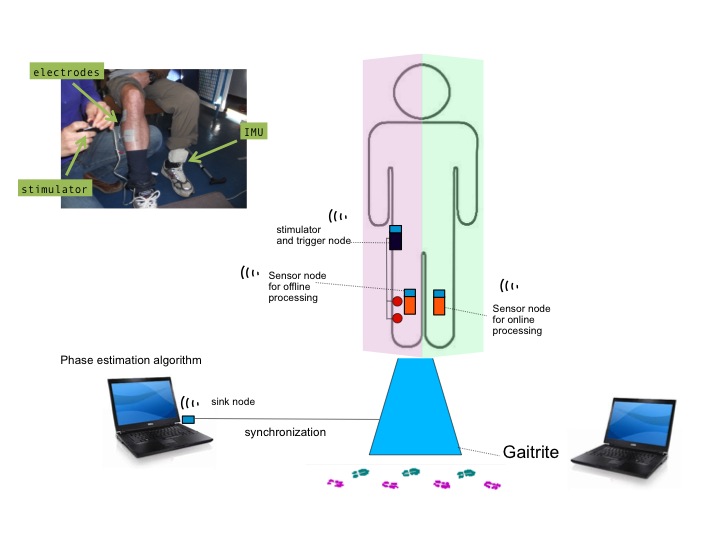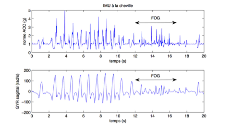Section: New Results
Function control and synthesis
Analysis of infection risk in surgery block
Participants : Christine Azevedo Coste, Roger Pissard Gibollet [SED Inria Grenoble Rhône-Alpes] , Gabriel Birgand [Bichat Hospital, Paris] , Jean-Christophe Lucet [Bichat Hospital, Paris] , Gaelle Toupet [Bichat Hospital, Paris] .
Despite the increasing implementation of preventive measures, surgical-site infection still induces a substantial burden. Inappropriate staff behaviors can lead to environmental contamination in the operating room and subsequent surgical site infection. The present study focuses on the continued assessment of operating room staff behavior using a motion tracking system, and the evaluation of the impact of this behavior on the surgical-site infection risk during surgical procedures.
A multicenter observational study has been done in 2013, including 10 operating rooms of cardiac and orthopedic surgery in 12 healthcare facilities. A motion tracking system including 8 optical cameras (VICON-Bonita®) recorded movements of reflective markers placed on the surgical caps/hoods of each person entering the room. Different configurations of markers positioning were used to distinguish between staff category. Doors opening were observed as well by means of wireless inertial sensors fixed on the doors and synchronized with the motion tracking system. We have collected information on the operating room staff, surgical procedures and surgical environment characteristics ([2] ).
Recorded data will be analyzed and staff behaviors will be assessed by the quantification of displacements within the operating room. Results will aim at bringing a rational to the prevention of airborne microorganism transmission by the description of best behaviors rules in the operating room.
This protocol was approved by the Institutional Review Board of the (IRB) of Paris North Hospitals, Paris 7 University, AP-HP (n° 11-113, April 6 2012). The work is supported by Inria SENSBIO ADT and ARIBO Preqhos project.
Drop-foot correction in post-stroke hemiplegic patients
Participants : Christine Azevedo Coste, Roger Pissard-Gibollet [SED Inria Grenoble Rhône-Alpes] , Jérôme Froger [Nîmes Hospital, Le Grau du Roi] , Claire Delablachelerie [Nîmes Hospital, Le Grau du Roi] .
Electrical stimulation has been proven to have orthotic and carryover effects on individuals with post-stroke hemiplegia with a foot drop syndrome. One of the drawbacks of the technique is the lack of adaptability to changes in gait (speed, type of floor, stairs, dorsiflexion quality etc). But, real-time modification of stimulation patterns is not feasible using gait event detection like proposed in all available stimulators. In the present study we investigate two questions: 1) is it possible to validate on individuals with foot drop an algorithm able to estimate online the continuous gait cycle phase from a unique wireless sensor placed on lower limbs and 2) is it possible to trig a drop foot stimulator based on events extracted from this phase information.
Methods : 20 subjects with post-stroke hemiplegia participated to the study. A wireless inertial measurement unit was placed on the unaffected leg of the subjects and was used to estimate the gait phase on a distant labtop. The subjects performed 3 trials in each of the 3 following conditions: C1 no stimulation aid, C2 electrical stimulation assistance triggered by heel switch C3 electrical stimulation assistance wirelessly triggered based on the proposed algorithm.
Results : 1) the proposed algorithm was able to estimate online the continuous gait cycle phase, 2) events could be extracted from this phase information in order to trig an electrical stimulator using this algorithm instead of heel switch.
Conclusion : the online estimation of continuous gait cycle phase on individuals with stroke is possible. Events can be extracted from the phase information in order to trig a stimulator C3 instead of using heel switch detection C2. The robustness of the proposed solution to gait modifications is intrinsically guaranteed by the use of automatic control theory. These results open promising applications using programmable stimulators which parameters could be modified online based on gait phase observation.
|
This protocol was approved by Nîmes Ethical Committee, AFSSAPS and CNIL. The work is supported by Inria SENSBIO ADT.
Freezing of Gait detection in Parkinsonian individuals
Participants : Christine Azevedo Coste, Christian Geny [CHU Montpellier] , Maud Pasquier [Inria Grenoble Rhône-Alpes] , Benoît Sijobert.
Parkinson’s disease (PD) is the second most common neurodegenerative disorder. This chronic disease can lead to gait disturbances and falls inducing important reduction of the quality of life. One common symptom is the Freezing of Gait (FOG), an episodic inability to generate effective stepping in the absence of any known cause other than Parkinsonism. It can occur during initiation of the first step, turning, dual task, walking through narrow spaces, reaching destinations or passing through doorways. It is an episodic absence or marked reduction of forward progression of the feet despite the intention to walk. FOG are reported by the patient as a subjective feeling of “the feet being glued to the ground”. Clinical evaluation of video recordings of patients by one to three observers is the gold standard to identify FOG events. The evaluation of clinical effects of the treatments would benefit from objective, standardized FOG measures. Moore et al. (2008;2013) have proposed a technique to identify FOG episodes based on the frequency properties of leg vertical accelerations (fig.9 ). The approach is based on the hypothesis that FOG occurrences are associated to trembling motion, which affect limb acceleration signal. They have introduced the so-called freeze index (FI): the ratio between the signal power in the trembling band (3 Hz - 8 Hz) and the signal power in the locomotor band (0.5 Hz-3 Hz). The FI method was validated using one to 7 accelerometers mounted on patients with satisfactory detection results. If many FOG episodes can be associated to festination (trampling) it is not the case for all of them. Therefore, we claim that all the FOG episodes cannot be detected by the FI method. In the present paper we propose a complementary index in order to take into account not only festination but also other freezing characteristics. Furthermore we intend to propose a solution based on a minimal number of embedded sensors and detection algorithms for future real-time applications.
This work is supported by SENSBIO Inria ADT and DEMARPARK AOI (see Partnerships and Cooperations section).
Effects of direct electrical stimulation of the brain during awake surgeries: towards improvements of the functional mapping
Participants : François Bonnetblanc, David Guiraud, Marion Vincent, Mitsuhiro Hayashibe, Hugues Duffau [Neurosurgery department, CHU-Gui de Chauliac] , Guillaume Herbet [Neurosurgery department, CHU-Gui de Chauliac] , Benedicte Poulin-Charronnat [LEAD, Univ. Dijon] .
« Awake surgery » consists in removing some infiltrative and slow-growing brain tumoral tissu in an awake patient. The neurosurgeon performs an anatomo-functional mapping of the brain by electrically stimulating brain areas near the tumor to discriminate functional vs. non functional areas. This stimulation is both made cortically and sub-cortically to preserve the functional connectivity. During the surgery itself, the patients are also involved by performing some tasks. Their recovery remains impressive with respect to the lesional volume. Despite the slow-growth of the lesion is invoked, these observations question our understanding of brain plasticity phenomena. Our multi-disciplinary approach aims to (i) better understand the effects of direct electrical stimulation of the brain to improve the functional mapping and also (ii) to build new functional assessments performed by the patient and based on new technologies applied to Health. By systematically performing these precise assessments before, after and during the surgery we hope to better understand brain functions, plasticity and dynamics in order to improve the surgical planning, functional mapping, rehabilitation procedures and quality of life of the patients.
Translational research and stroke
Participants : Anirban Dutta, David Guiraud.
Stroke is caused when an artery carrying blood from heart to an area in the brain bursts or a clot obstructs the blood flow thereby preventing delivery of oxygen and nutrients. About half of the stroke survivors are left with some degree of disability where the impairment of walking has been mentioned most frequently as the most important disability. There is, therefore, a pressing need to leverage insights from animal and human studies to address the complexity in clinical translation of rational multi-level electrotherapy protocols where the ability to customize such novel electrotherapy protocols has only recently become possible with advanced computational tools. Therefore the challenge is to develop advanced computational modeling tools at Inria, France, to design and customize innovative electrotherapy protocols to patient-specific needs, and then closely integrate them to drive (perhaps the first) individualized non-invasive electrotherapy program for clinical validation. The ongoing steps are i) Develop computational methods to identifying neural circuits related to the recovery from stroke [26] , ii) Develop a computational method for online targeting of neural circuits and related pathways with non-invasive electrotherapy [21] ,[25] , iii) Validate individualized multi-level non-invasive electrotherapy program with NIBS as an adjuvant treatment to NMES-assisted gait rehabilitation following stroke.
Projet PERIMED
Participants : Thomas Guiho, Christine Azevedo, Luc Bauchet, Charles Fattal, David Guiraud, Jean-Rodolphe Vignes.
Born in the 70’s, Spinal cord stimulation is a general term including both peridural and intradural stimulation. Encouraged by Harkema’s clinical result (in one paraplegic patient with step-like EMG activity) [43] , several recent studies in rodents elicited locomotor synergies, bladder/bowel improvements and, in certain circumstances, restoration of supraspinal control after spinal cord injury [45] . Based on this previous work, our approach, mainly focused on bladder and bowel functions, aims both at asserting these discoveries in an intermediate model (pigs weighing between 50 and 60 kgs) and at providing further insight in spinal cord circuitries.
Investigation of strategies for selective small nerve fiber stimulation in an animal model
Participants : Paweł Maciejasz, Olivier Rossel, Christine Azevedo Coste, David Andreu, David Guiraud, Hubert Taillades [Institute of Biology, Montpellier] .
The electrical stimulation of nerve fibers may allow to restore or augment some body functions lost due to disease or injury. However, in typical peripheral nerves there are thousands of nerve fibers with various diameters and functions. When standard rectangular pulses are used for nerve fiber stimulation, the big fibers are activated before smaller ones. However, for many clinical applications it would be beneficial if small fibers could be activated without activation of the big ones.
Already many stimulation techniques have been proposed for fiber type and diameter selective stimulation, e.g. analog block, slowly rising pulses, high frequency block. However, due to limited efficiency of those techniques, they are still not used in clinical practice. Based on the results of the computer simulations and the experiments performed previously in the earthworm model by our team, we have proposed some modification to the existing techniques, that may increase their efficiency.
In order to verify if the proposed modifications allow for increased selectivity of stimulation as compared to the techniques already proposed, a series of experiments in rabbit model has been scheduled. The experiment consists of two phases. The objective of the first one (3-6 rabbits), the preliminary one, is to determine an adequate method to evaluate the effects of stimulation, i.e. to find out a reliable method that would allow for discrimination between various types of fibers being activated by the stimulation. The objective of the second phase (5-15 rabbits), the exploratory one, is to compare and quantify the performance of various strategies for fiber type selective stimulation.
The experiments have been performed by the DEMAR team in rabbits in the Institute of Biology in Montpellier. During this experiment the sciatic nerve of the rabbit has been stimulated using tripolar nerve cuff electrode, whereas ENG and EMG signals, as well as ankle torque have been recorded. The experiments have been started in December 2012 and so far only the first phase of the study has been completed.
The experiment was authorized through the local ethics committee for animal experiment (authorization N° CEEA-LR-12084). The work is supported by INTENSE Project.





